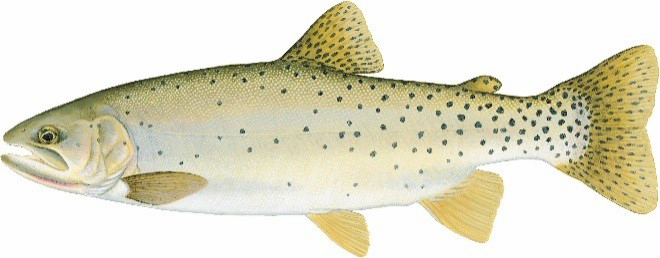The Cutthroat trout (Oncorhynchus clarkii) is native to the cold-water tributaries of the Pacific Ocean, from California to Alaska, the Rocky Mountains, and Great Basin in North America.
Its species, clarkii, was named to honor Captain William Clark, of the Lewis and Clark Corps of Discovery Expedition (1803-1806), who described the fish in his diary.
There are 14 sub-species of cutthroat trout, two of which are extinct.
The cutthroat trout is a member of the family Salmonidae.
Size and Coloration
Cutthroat trout (Illustration from KDFWR)
This fish was originally known as the black spotted trout, but in the late 19th century the name that came to be accepted was cutthroat trout, because of a distinctive reddish-orange slash on the fish’s lower jaw.
With so many sub-species, body coloration varies considerably, from gold, copper, or pale yellowish to gray. Some subspecies have red blotches on their sides and gill plates, but what separates the cutthroat from other trout species is its pattern of dark spots. There are very few dark spots on its head and sides, but they become more numerous towards the caudal fin (tail).
On April 16, 2019 fishery personnel of the Kentucky Department of Fish and Wildlife Resources (KDFWR) stocked cutthroat trout in Kentucky for the first time — 38,000 in the Cumberland River below Wolf Creek Dam.
Fishery biologists can only guess what the cutthroat trout growth rate is going to be here, but throughout its range, its growth rate is comparable to the brown trout, which takes about five years, on average, to reach 20 inches.
Expectations are that cutthroat trout could reach 10 pounds in the Lake Cumberland tailwaters.
Distribution in Kentucky
The cutthroat trout stocked in Kentucky were surplus Yellowstone strain cutthroat trout, spawned and raised up to stocking size at the Norfork National Fish Hatchery in Arkansas. KDFWR crews stocked 5,100 trout at Bakerton, KY., 21,600 at the ramp at Burkesville, KY., and 11,300 at the Ky. 61 bridge, just downstream from Burkesville. The stocked trout averaged just over 6 inches long.

Yellowstone Cutthroat Trout (Photo from U.S. Forest Service)
Hopes are that more cutthroat trout will be available for stocking in the Lake Cumberland tailwaters in the future. The Yellowstone strain is native to the mountain headwaters of the upper Missouri River drainage.
Food Habits
The cutthroat trout is an opportunistic feeder, with a diverse diet.
Like all trout species in Kentucky, they consume larval, pupal, and adult forms of aquatic insects, typically caddisflies, stoneflies, and mayflies.
They also eat crayfish and small amphibians. As they grow larger, small fish make up a higher proportion of the cutthroat trout’s diet.
Fishing Tips
Spinners, crankbaits and small spoons fished on ultralight spinning tackle will catch cutthroat trout.
Fly fishermen can catch these trout on streamers, dry flies and nymphs.

Credit: Source link































